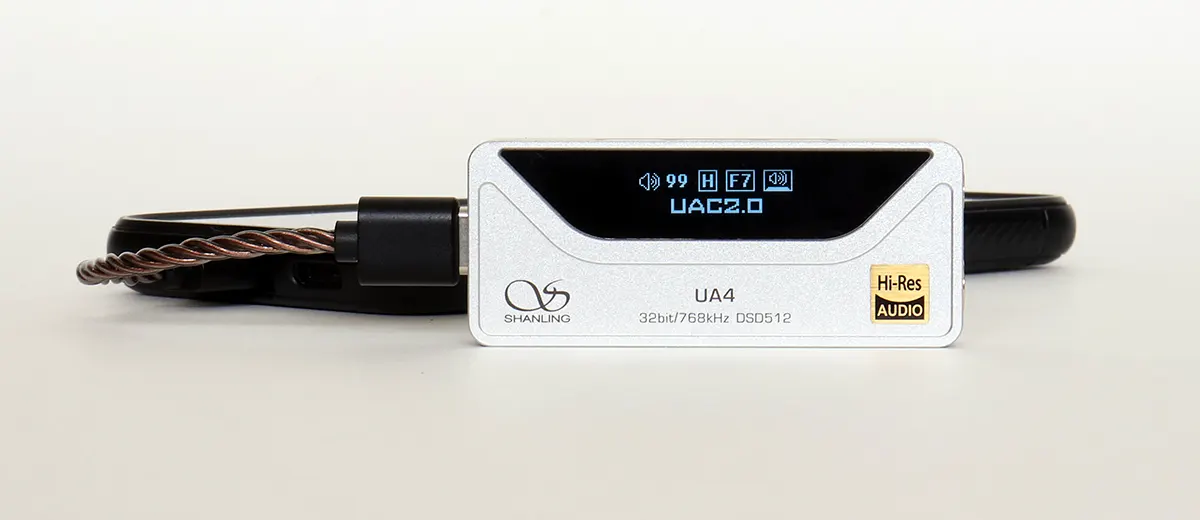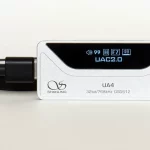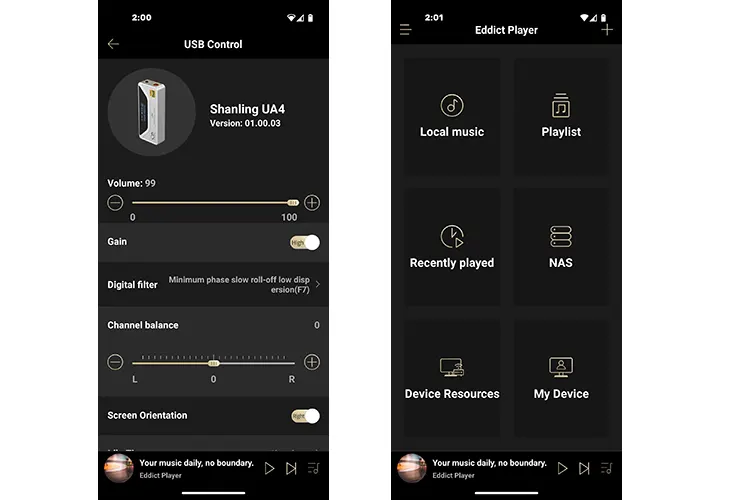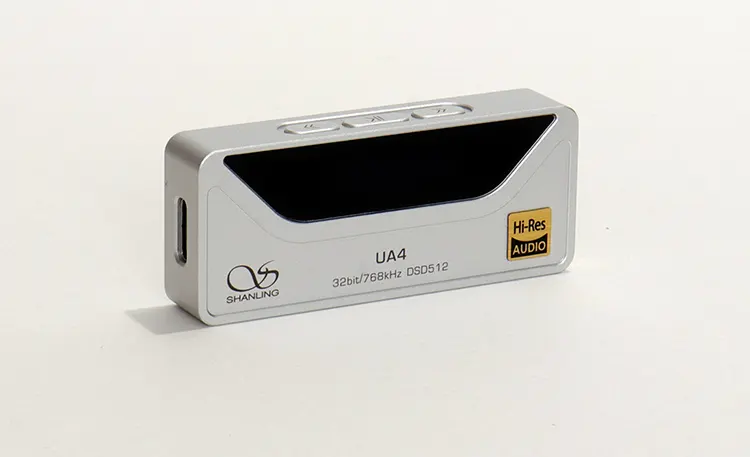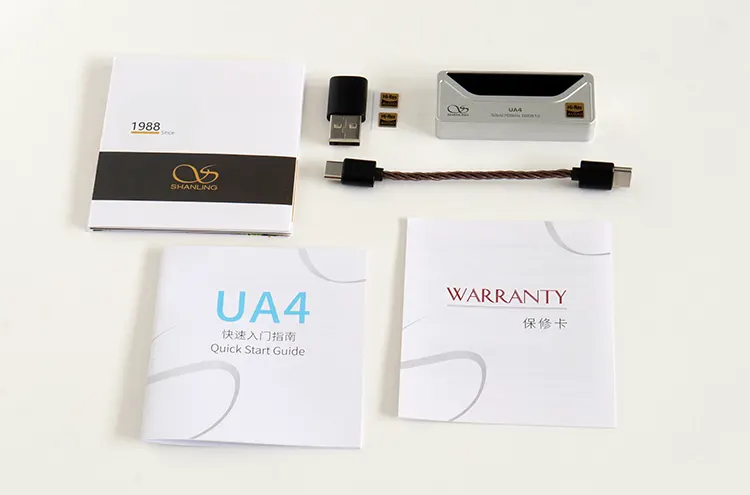Today, Louis reviews the Shanling UA4, which is a new ESS ES9069Q-equipped dongle DAC for both IEM and headphone users with up to 227mW of balanced output power. It is priced at $99.
Disclaimer: This sample was sent to me in exchange for my honest opinion. Headfonics is an independent website with no affiliate links or status. I thank Shanling for their support.
To learn more about Shanling products we previously assessed on Headfonics click here.
Note, that this article follows our current scoring guidelines which you can read here.
Shanling is calling the recently launched UA4 dongle DAC the ‘new reference’ but I’m assuming at $99 SRP that statement is in context to their dongle lineup since above it sits a few more expensive heavy hitters like the Cayin RU7, the iFi Audio GO bar, and the Questyle M15.
At this price point, I’m also wondering if it can surpass the TOTL Shanling UA5. From what I can see and from what’s visible on the surface, the UA4 seems to combine new and old tech inside a new, completely redesigned shell design.
The Shanling UA4 does have a lot going for it besides a new chipset. It’s also one of the most gallant dongle DACs I’ve seen and certainly within Shanling’s dongle DAC lineup. The UA4 is available in two colors, silver, and grey.
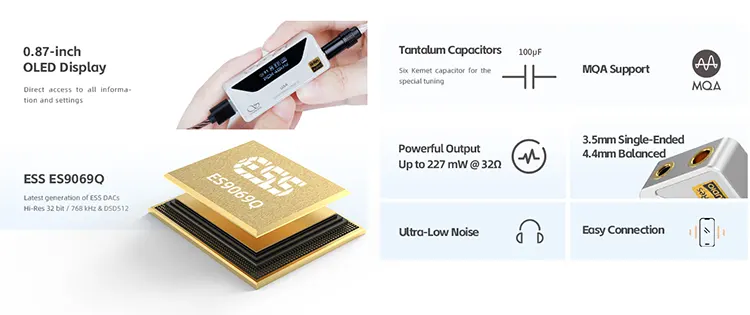
Features
DAC
The Shanling UA4’s spotlight is mostly placed on its new, fourth-generation ESS ES9069Q DAC implementation which is improved upon over past ESS variant DACs.
These chips promise improved sonic quality, and time domain performance improvement that translates into zero jitter.
These ESS DAC chips are 2-channel digital converters with a THD-N rating of 120 dB. Although performance has increased over past ESS DACs, power consumption is reduced. This makes this DAC a good candidate for these types of devices.
The DAC section feeds a pair of RT6863 headphone amplifiers that can supply up to 227mW per side on the balanced 4.4mm connector at 32Ω and 137mW at the same 32Ω on the single-ended output. This dongle seems to have a 2-volt output on the SE side and around 4 volts on the balanced side.
Another interesting aspect of the UA4 is the sextuplet set of 100µf Kemet Tantalum capacitors that Shanling uses as a special tuning toolset within the circuitry.
That, along with a low-dropout regulator, and ultra-low noise LDOs, Shanling was able to obtain a black background, free from hiss and unwanted noise.
Decoding
The Shanling UA4 can decode PCM up to 32bit/768kHz rates, native DSD512, and MQA up to 16x.
If I can say a few words on stability, most dongle DACs, particularly older variants tend to break up if you feed them a multichannel audio source but this one doesn’t mind and seems rock solid on that front. Even a popular PC game like COD, for example, tends to break down previous dongle DACs but not this one.
The UA4 uses a USB 2.0 interface but is also capable of dropping down from USB 2.0 to 1.0 to improve compatibility and gain the capability of running on most gaming consoles, So yeah, get your game on. Run an ASIO driver and set that latency to low. Go for it.
Software
It seems Shanling put some work into their app from the first time I used it a while back. Their app is called Eddict Player but it’s more than just a player and has a lot of buried features.
The Eddict player app can stream music from a NAS just as well as whatever you have in local storage. Within this app, you can access the eight internal DAC digital filters, channel balance adjustment, and even control idle time and the backlight brightness of the display.
The player itself carries over all the general features like the fixed 10-band graphic equalizer. The overall sonic tuning is neutral and on the safe in stock form.
I did have one major hiccup with this app which was a trivial one and that was the inability to close the app completely and easily. I had to physically go in and kill the app manually by going into the app info and performing a force stop because it would keep running in the background.
Design
The UA4 is a very refined-looking dongle DAC and is one of the nicest builds I’ve seen, especially from within the Shanling dongle DAC lineup.
First off, there’s not a single sharp edge or corner anywhere and the metalwork is impeccable. It looks as though this shell is molded or cast because there are no CNC cut marks anywhere and all the surfaces are smooth polished matte aluminum.
The backplate seems to be a single piece of tempered glass with some product information. I would have loved to have seen Shanling push the boat out here with a window that lets you peek at the internal hardware just to give it some additional flair.
The front side of the UA4 is the most attractive part of this dongle. That’s where you’ll find the 0.87” OLED display that is unique due to it having a screensaver musical note that scrolls by when the dongle goes into a display idle time-off mode. It’s the first time I’ve seen a screensaver on a dongle.
I/O
The UA4 I/O consists of the usual USB-C input and a dual headphone output section that consists of a 3.5mm single-ended port and a 4.4mm Pentaconn balanced output.
The USB-C as mentioned can be dropped down to a USB 1.0 port but aside from that the port is compatible with Windows, Android, and IOS, plus I even tried the UA4 on a Chromebook successfully.
Aside from that, onboard volume buttons control the general output ports with further adjustability within the Eddict app in the form of a max volume level adjustment feature plus a balance adjustment feature.
Controls
Aside from the volume buttons, there is a third button that handles pause and play while you’re using a mobile device or a media player. Plus it also gives access to an onboard main menu that includes many features.
A quick tap brings you to a general screen that shows the USB version and some general information.
However, when you press and hold, the menu shows up and at that point, you can make adjustments with a combination of the multifunction button tap and the volume button set. A second press and hold takes you out of the menu.
Within the menu, you’ll find a two-level gain control, 8 digital filters, a key mode, a font selector, a balance control, a brightness control, an idle time adjustment, and a screen orientation selector.
This feature set is comparable to Shanling’s UA5 feature set minus the SPDIF because that feature is not available on the UA4. It’s all there minus that. Remember, we’re talking about Shanling’s top dongle DAC model.
Packaging & Accessories
I’ve gotten familiar with Shanling’s flip-top box with its custom foam mold inside that holds the dongle along with a USB-C to full-sized USB adapter.
The same dual-sided USB-C cable is included that was included with the UA1 Plus and the H5 of recent. It’s a twisted 4-wire four-inch cable, black anodized connector housings with short strain reliefs, and most likely assembled with OFC wire.
The rest of the accessories consist of paper. There’s a warranty pamphlet, a quick start guide, and a product brochure. I also found two Hi-Res stickers inside the box.
Sound Impressions
I broke out my HIFIMAN Sundara’s for this to get a sense of drivability and efficiency plus this is a headphone that lots of our readers already own and are familiar with.
My set is modded with Dekoni’s Fenestrated pads which seem to leave most of the original sonic qualities intact. However, they inject a smudge of bass due to the small increase in ventilation. I also used Meze Audio’s upgraded silver cable terminated with a 4.4mm Pentaconn jack.
Summary
The Shanling UA4 is a small leap ahead of the previous models sonically and it’s attributed to the refined DAC section that improves in some ways over past models like the UA2 and possibly the UA5 that use the older ES9038 variant chip. The UA3 is unique in that it uses an AK4493.
The Shanling UA4 offers a very clean presentation, almost hygienic in presentation. But that same character allows a sharp image of the music being played through this dongle. It does strike a balance between musical and analytical.
One obvious thing is the absence of noise. The UA4 has a very dark, silent canvas that allows all the small details to come through along with a clear presentation of the recording.
The full frequency response is fully represented, and there’s plenty of energy and presence that retains detail and dynamics. So I would say that the UA4 is a smear away from producing a stellar performance sonically.
Staging and Dynamics
The UA4 is rather focused and presents the listener with a soundstage that’s abundant with sharply defined elements. It’s one of the best dongle DACs at staging I’ve tested.
It has a spacious sound signature that doesn’t lose itself, remains coherent, and always remains intent on showing each element within a small isolated space.
Does it have enough grunt to power up some demanding cans and still produce ample bass? Perhaps not but if your main pairing component will be an IEM, then you’ll more than likely feel enough energy in the lower region to satisfy.
Does the UA4 supply some wow factor? The dynamic responsiveness of this dongle helps produce a speedy attack and decay that energizes the listener and keeps them entertained.
Click on page 2 below for my recommended pairings and selected comparisons.

